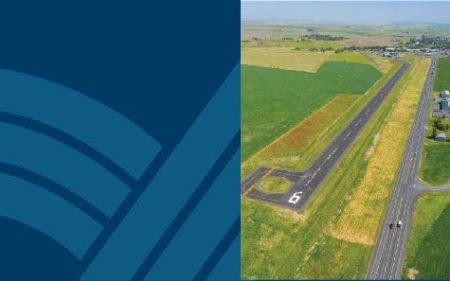Davenport Municipal Airport’s (Airport) Runway 5-23 Shift, Extension, and Reconstruction Project significantly improves the safety and efficiency of the airfield for its local and regional users while extending overall pavement life. This project is the culmination of nearly 13 years of effort by the City of Davenport (City) to safely control its Runway Protection Zones (RPZs), meet current Federal Aviation Administration (FAA) design standards, accommodate the existing and projected aircraft fleet mix, and remedy its line-of-sight deficiency. Through planning, Environmental Assessment (EA), land acquisition, obstruction removal, design, phasing, and construction, the City and Century West obtained and administered FAA and Washington State Department of Transportation (WSDOT) grant funding while holding to the overall program schedule and budget. The project’s investment in runway safety prompted cooperation across agencies and stakeholders to enhance and expand prime developable land to meet the growing interest in the Airport.
Established in the 1940s as a grass airfield and paved in 1973, the Airport is managed by the City and has grown to serve predominately single- and twin-engine aircraft associated with business and personal travel and aerial applicator operations. In recent years, the Airport has begun to support aerial firefighting and air ambulance operations. Concurrent with its increasing popularity, the Airport’s primary runway, 5-23, continued to exhibit widening transverse cracking. The 2009 Airport Layout Plan Update identified several additional deficiencies warranting a long-term program to bring the Airport into compliance with modern FAA safety standards. These deficiencies included the Runway 23 RPZ extending over private residential areas, off-airport penetrations to the Part 77 20:1 Approach Surface, a runway length insufficient to support the existing and forecasted aircraft fleet mix, and a runway width too narrow to meet current design standards. There was also a significant “hump” near the middle of Runway 5-23 that caused a non-compliant line-of-sight deficiency. For decades, this “hump” presented a significant safety hazard to pilots and airport users.
The City hired Century West to assist with initiating a multi-year, multi-phase effort to bring Runway 5-23 compliance. Before design and construction could take place to address the runway condition, the City had to partake in an EA effort followed by an FAA-grant funded land acquisition to purchase land for the RPZ. Concurrent with this process, Century West helped the City work with a local utility provider to bury overhead lines in the area of the future RPZ. Additionally, Century West led a preliminary Precision Approach Path Indicator (PAPI) siting analysis and AGIS Obstruction Evaluation for the future runway to ensure the final project would not encounter future issues. Also within this timeline, Century West assisted the City with the official closure of the aggregate-surfaced crosswind Runway 4-22, an FAA prerequisite for the reconstruction of the primary runway.
With the preliminary work completed, Century West proceeded to project design. This process revealed an unusually challenging climate and soil conditions for frost protection. Extensive technical coordination with the FAA refined the pavement section’s frost protection to maintain cost-effectiveness while still ensuring a full pavement design life. In addition to subbase drainage through a full underdrain system, a site-wide stormwater drainage and conveyance system was designed to effectively channel water through the site.
During final design of the Runway 5-23 project, the City was notified that it was shortlisted for additional funds that they chose to put toward the design and construction of the new Taxiway F that would accommodate relocated aerial applicator operations. The runway project had already been bid but the same contractor came in as the low bid on the added taxiway portion, saving the City on deployment costs. Construction was substantially complete in 2021 and delivered within the original schedule and program budget.
Throughout the runway improvement project, the Airport doubled its number of resident hangars in anticipation of the enhancements. Once the runway and its associated improvements were completed, the City was able to secure a long-term lease for a permanent air ambulance service, adding to the life-safety benefits of the improved runway geometry. As an economic engine, the improvements to the runway spurred improvements to and expansion of developable lands within the Airport. In cooperation with, and grants from, the City of Davenport, Lincoln County Economic Development Council, Lincoln County, WSDOT Aviation, and other stakeholders, primary utility infrastructure was extended within the hangar development area to satisfy the growth sparked by the project. With the closure of the crosswind runway, the project freed up approximately 500,000 square feet of prime development land for future commercial and light industrial opportunities.
Concluding an effort that began with the 2009 ALP Update, the City has established a new era for the Davenport Municipal Airport. The Runway 5-23 Shift, Extension, and Reconstruction Project ensures Davenport can offer the region’s aviation community a safe, efficient, and FAA-compliant primary runway. The runway project completion opens the opportunity for the Airport to construct PAPI units, secure an additional fenced perimeter, and offer prime developable hangar space near Spokane’s major metropolitan area. For these reasons, the project was awarded Airport Project of the Year at the 2022 Washington Airport Managers Association conference.







